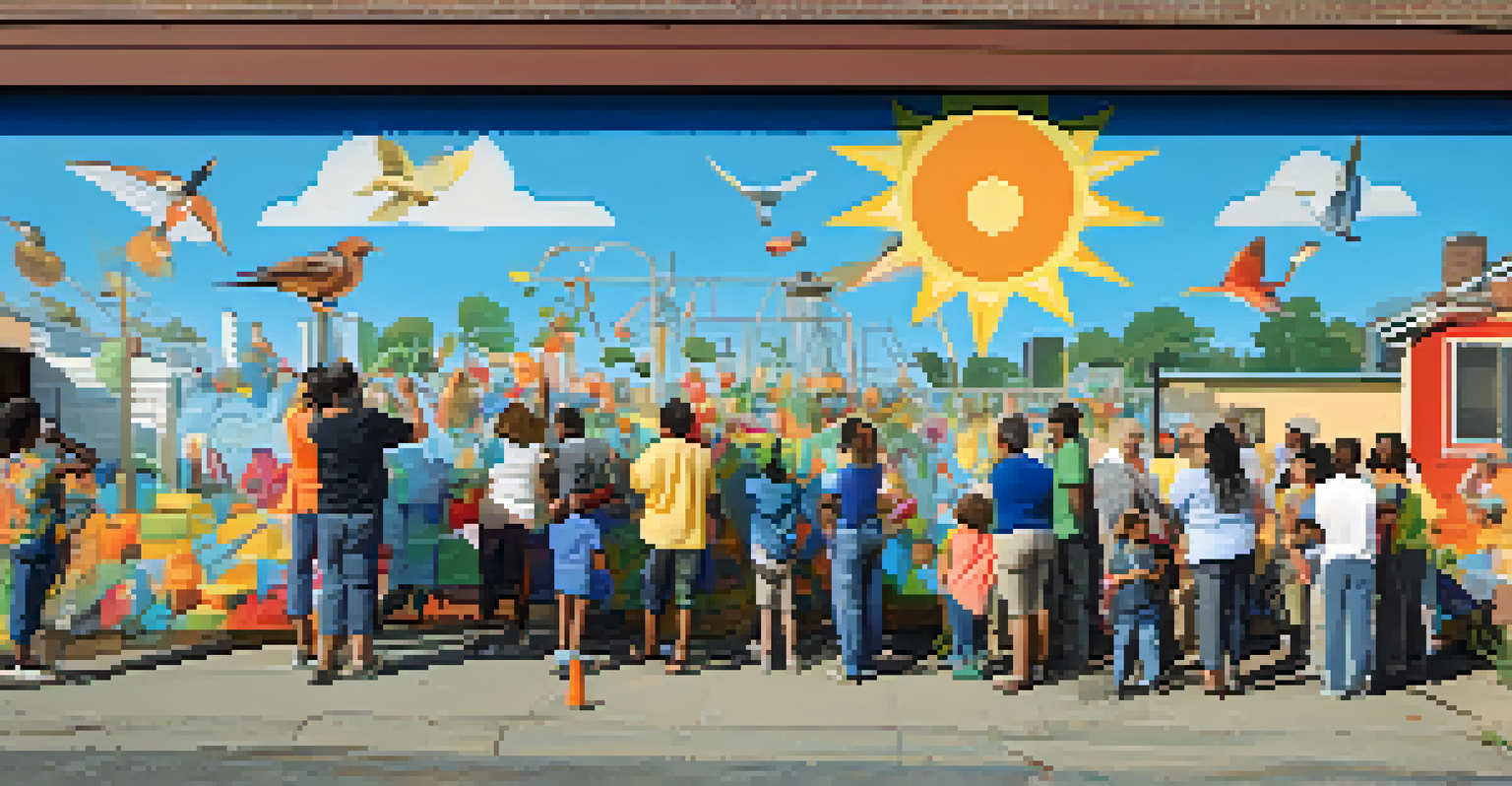Environmental Themes in Public Art: A Call to Action

Introduction: The Intersection of Art and Environment
Public art has always been a reflection of societal values, and in today’s world, environmental themes are more prominent than ever. Artists are using their platforms to spark conversations about climate change, pollution, and sustainability. This intersection of art and the environment serves as a powerful reminder of our collective responsibility towards nature.
Art is not a mirror to hold up to society, but a hammer with which to shape it.
As cities become more urbanized, the role of public art in promoting environmental awareness is crucial. These artworks can transform spaces, encourage dialogue, and inspire action among community members. By embedding environmental themes into public art, artists can create a visual language that resonates with a diverse audience.
Through murals, sculptures, and installations, artists are not only beautifying public spaces but also challenging viewers to rethink their relationship with the environment. This article explores various aspects of environmental themes in public art and emphasizes the urgent call to action that these works embody.
Historical Context: Art as a Reflection of Environmental Issues
Throughout history, art has mirrored the concerns of society, including environmental issues. From the Romantic movement’s awe of nature to the stark realities presented in contemporary art, artists have used their work to comment on humanity's impact on the planet. Understanding this historical context helps us appreciate how public art continues to evolve in response to environmental challenges.

In the 1960s and 70s, environmental movements began to gain momentum, leading artists to create works that highlight ecological concerns. These early efforts laid the groundwork for the integration of environmental themes into public art today. It’s fascinating to see how past movements have influenced modern expressions of environmental advocacy through art.
Art Raises Environmental Awareness
Public art serves as a powerful medium to spark conversations about climate change and sustainability.
By examining historical trends, we can see a clear trajectory towards a more engaged approach to environmental issues in art. This journey underscores the importance of artists as catalysts for change, continually pushing the envelope to raise awareness and provoke thought about our environmental responsibilities.
Case Studies: Successful Environmental Public Art Projects
Several public art projects around the globe have effectively highlighted environmental issues, proving the medium's potential for advocacy. For instance, the 'Plastic Bag Monster' installation in Cape Town visually represents the ecological threat of plastic pollution, engaging the community in critical conversations. Such projects not only raise awareness but also encourage local action towards environmental conservation.
We do not inherit the earth from our ancestors; we borrow it from our children.
Another notable example is the 'Green Roofs' initiative in Chicago, where artists collaborated with architects to create eco-friendly public spaces adorned with vibrant art. This project not only beautifies the city but also promotes biodiversity and sustainable practices. The integration of art with environmental functionality showcases how creative solutions can tackle pressing ecological challenges.
These case studies demonstrate the power of public art to inspire communities and drive action. By transforming public spaces into platforms for environmental dialogue, artists can leave a lasting impact on both individuals and the community as a whole.
Community Engagement: Art as a Tool for Environmental Advocacy
Public art projects often involve community participation, making them effective tools for environmental advocacy. When community members are involved in the creation of art, they develop a deeper connection to the issues being addressed. This participatory approach not only fosters a sense of ownership but also empowers individuals to take action in their own lives.
For example, community murals that address local environmental issues can serve as visual reminders of the collective responsibility to protect the planet. These artworks can spark discussions, workshops, and even local initiatives aimed at promoting sustainability. The collaborative nature of these projects fosters a sense of unity and purpose among participants.
Community Engagement is Key
Involving community members in public art projects fosters a deeper connection to environmental issues and empowers action.
By engaging communities in the artistic process, public art becomes a catalyst for broader environmental movements. This grassroots approach reinforces the message that everyone has a role to play in creating a more sustainable future, making the call to action even more compelling.
Artistic Techniques: Innovative Approaches to Environmental Themes
Artists are employing innovative techniques to convey environmental themes in public art. From using recycled materials to incorporating technology, these creative approaches enhance the message while minimizing ecological footprints. For instance, installations made from repurposed waste not only challenge viewers’ perceptions but also highlight the importance of recycling and waste reduction.
Additionally, interactive art pieces that engage viewers in real-time can create a more immersive experience. For example, digital projections that respond to environmental data can visually demonstrate the impact of climate change. Such techniques invite audiences to engage with the art on a personal level, fostering a deeper understanding of the issues at hand.
These artistic techniques not only capture attention but also encourage viewers to think critically about their own environmental practices. By blending creativity with innovation, artists can effectively communicate urgent messages and inspire positive change.
Challenges Facing Environmental Public Art Initiatives
Despite the positive impact of public art on environmental advocacy, there are challenges that artists and communities face. One major hurdle is funding, as many public art projects rely on grants or sponsorships that may not always be available. This financial limitation can stifle creativity and prevent impactful projects from coming to fruition.
Moreover, there can be resistance from local authorities or community members who may not prioritize environmental themes in public art. Addressing concerns about aesthetics or appropriateness can impede the progress of important projects. Building consensus and demonstrating the value of environmental art is crucial for overcoming such barriers.
Support for Art is Crucial
Supporting public art initiatives amplifies the messages of artists and cultivates a culture of environmental advocacy.
Lastly, the ever-changing landscape of urban development can pose a threat to existing public art. As cities grow, artworks may be removed or neglected, diminishing their impact. Advocating for the preservation of environmental art is essential to ensure that these messages continue to resonate within communities.
A Call to Action: Encouraging Support for Public Art Initiatives
Given the significant role that public art plays in environmental advocacy, it’s essential for individuals to support these initiatives. Whether it’s attending art openings, participating in community projects, or advocating for funding, each action contributes to a larger movement. By showing support, we can help amplify the messages of artists and foster a culture of environmental awareness.
Additionally, spreading the word about successful public art projects can inspire others to get involved. Sharing stories on social media or organizing community discussions can generate interest and drive action. The more we talk about these issues, the more likely we are to create a collective shift towards sustainability.

Ultimately, the call to action extends beyond just supporting art; it’s about embracing a mindset that values creativity as a means of addressing environmental challenges. By rallying together, we can create a vibrant network of advocates dedicated to using art as a powerful tool for change.